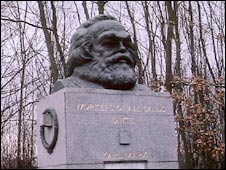Neil: Do you like living in the big city, Jean?
Jean: Yeah, but, you know, sometimes it's a little hectic. It's nice to go somewhere peaceful to relax.
Neil: I know what you mean. Have you ever thought about a visit to a cemetery?
Jean: A cemetery? 公墓陵园!Neil 建议我去公墓看看。 Hmm, is it really that interesting?

Karl Marx's grave in Highgate Cemetery
Neil: Oh yes, of course! I know a huge old cemetery, in a really nice part of London and it contains the graves of some very famous people. It's really peaceful and extremely interesting.
Jean: 这是一座规模巨大,历史悠久的公墓陵园,有很多著名人物的坟墓 graves. OK, tell me more!
Neil: Welcome to On the Town from BBC Learning English. I'm Neil. In this programme, we hear all about interesting places to visit in Britain.
Jean: 大家好,我是董征。在我们BBC《都市掠影》节目中,我们为大家介绍英国各地好玩好看的地方。
Neil: Listen to this BBC reporter describing Highgate Cemetery:
Highgate Cemetery is a private cemetery and a grade-two listed heritage site with 169,000 people buried in 52,500 graves.
Neil: She says it's a private cemetery and a grade-two listed heritage site. Heritage.
Jean: 历史遗址或天然胜地就是 heritage.
Neil: Site.
Jean: 遗址 site.
Neil: Heritage site.
Jean: 历史遗址 heritage site.
Neil: In Britain, if a building is of special architectural or historical significance, it's given special status. We call it a 'listed building'.
Jean: 在英国,如果一座建筑具有特别的历史意义或者建筑学价值的话,这所建筑会被授予特别的资格 - 我们叫它登录建筑 listed building.
Neil: The most important buildings and sites are called grade one, the next most important are…
Jean: Grade two?
Neil: You've got it!
Jean: 最重要的建筑和遗址是一类建筑,比这类建筑稍次一等是二类建筑。
Neil: Here she is again:
Highgate Cemetery is a private cemetery and a grade-two listed heritage site with 169,000 people buried in 52,500 graves.
Neil: Did you hear how many people are buried in Highgate cemetery?
Jean: 169,000 people 16万9千人被葬在这里。 So it's a pretty big place.
Neil: That's right. It was founded in 1839. Founded.
Jean: 创办了 founded.
Neil: And it quickly became the most fashionable place of rest in the Victorian era. Place of rest.
Jean: 安息之地 place of rest. 维多利亚时代 Victorian era.
Neil: The Victorians were fascinated by ancient Egypt and you can see this in the architecture of the tombs and family vaults. Tombs.
Jean: 就是坟墓。维多利亚时代的人们对古埃及文化十分热衷,所以在这里我们可以看到墓柩和灵堂的建筑风格也体现出了这样的影响。坟墓就是 tombs; 灵堂 vaults. Neil, you mentioned that there are famous people buried in Highgate Cemetery.
Neil: That's right, about 850. For example, members of Charles Dickens's family are buried there. There are also politicians, scientists, businessmen, actors and writers.
Jean: 是的,查尔斯•狄更斯的家人和其他的政治家、科学家、企业家、演员、作家等等都葬在这里。
Neil: But there is one grave which is by far the most famous.
Jean: Oh really, who's that? Neil 说在这众多的坟墓之中有一座里面埋葬的人是他们之中最有名的。
Neil: Well, have a listen to some of the things he said and see if you can guess.
Jean: OK. 让我们来听听下面的这几句名言,看大家能不能猜得出来说过这些名言的人是谁。
"Workers of the World Unite!", "You've nothing to lose but your chains" and "From each according to his abilities, to each according to his needs".
Neil: He said "Workers of the World Unite!"
Jean: 全世界的劳动人民团结起来!
Neil: "You've nothing to lose but your chains."
Jean: 除了你们身上的锁链,你们不会失去更多。
Neil: And "From each according to his ability, to each according to his needs".
Jean: 各尽所能,按需分配。
Neil: It is, of course, Karl Marx.
Jean: 没错,卡尔•马克思就被安葬在海格特公墓。
Neil: Karl Marx lived and worked in London for the last 34 years of his life. His grave is marked by an enormous bust.
Jean: 半身像 bust.
Neil: So Jean, if you want to spend a morning or afternoon in peaceful surroundings, looking at some interesting architecture and seeing the resting place of some of the most important people of the Victorian age, I can recommend Highgate Cemetery to you.
Jean: I think I'll check it out! Join us again soon for more On the Town.
Neil: And if you want more help with your English, go to our website.
Jean: 我们的网站就是 www.bbcukchina.com.
Neil: Bye.
Jean: See ya!